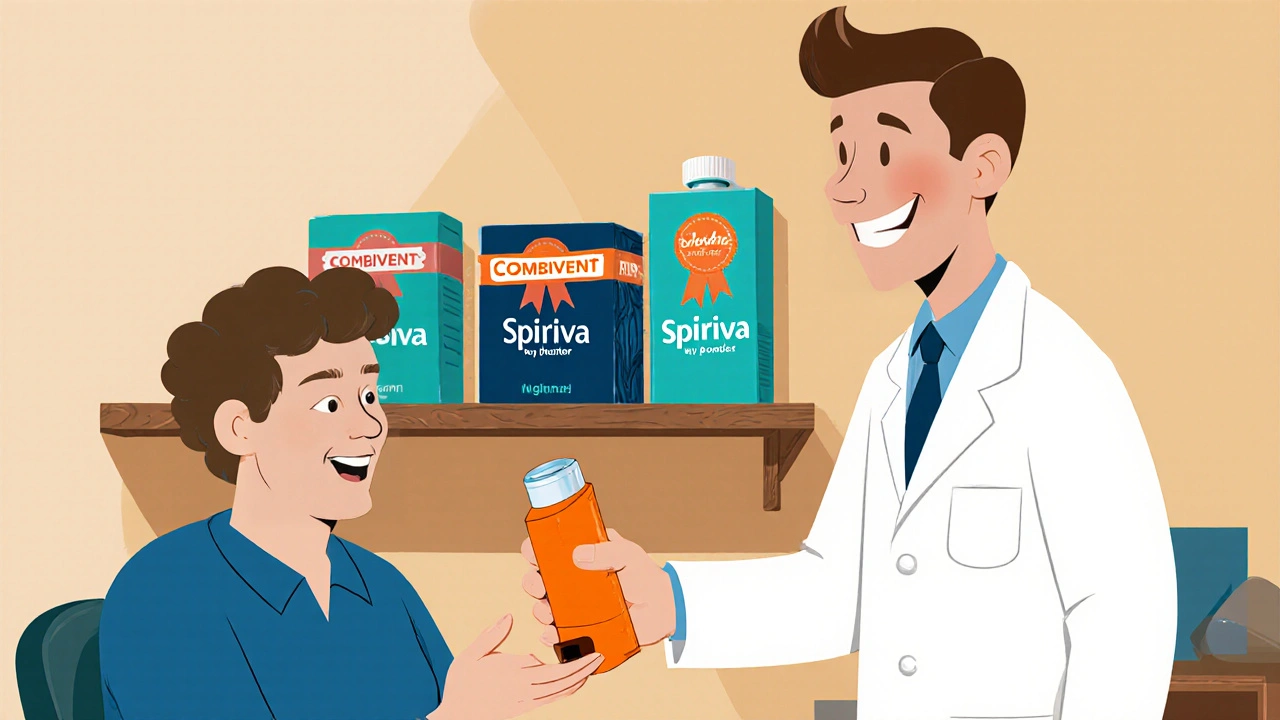Combivent vs Alternatives: Which Inhaler Is Best for COPD & Asthma?
 Oct, 16 2025
Oct, 16 2025
Inhaler Selection Tool
Find Your Best Inhaler Match
Answer these questions to get a personalized recommendation based on your symptoms, usage frequency, and preferences.
When your doctor prescribes a rescue inhaler, you want to know how it stacks up against the other options on the shelf. Combivent (a fixed‑dose combination of albuterol and ipratropium) is a popular choice for people with chronic obstructive pulmonary disease (COPD) and asthma, but it isn’t the only game‑in‑town. This guide walks you through the science, the price tags, and the real‑world pros and cons so you can pick the inhaler that matches your breathing pattern.
Key Takeaways
- Combivent pairs a short‑acting beta‑agonist (albuterol) with a short‑acting anticholinergic (ipratropium) for rapid, dual‑action relief.
- Alternatives fall into three buckets: single‑agent bronchodilators, other fixed‑dose combos, and long‑acting maintenance inhalers.
- Price and device preference often decide the winner, not just pharmacology.
- For severe COPD, a long‑acting anticholinergic like Spiriva may outperform Combivent on symptom control.
- Always match the inhaler’s speed of onset with your symptom severity - quick‑acting for attacks, long‑acting for prevention.
What Is Combivent? (Albuterol+Ipratropium)
Combivent is a fixed‑dose inhalation spray that combines albuterol (a short‑acting beta‑2 agonist) with ipratropium (a short‑acting anticholinergic). The blend delivers two complementary mechanisms: albuterol relaxes airway smooth muscle quickly, while ipratropium blocks the vagus‑nerve‑driven bronchoconstriction that albuterol alone can’t fully suppress. The product debuted in the U.S. in 1996 and has since become a staple for COPD flare‑ups and exercise‑induced asthma.
Combivent is delivered via a metered‑dose inhaler (MDI) that spits out 0.5mg albuterol and 0.5mg ipratropium per actuation. Typical dosing is two inhalations every 4‑6hours as needed, not exceeding eight puffs per day.
How Combivent Works: The Dual‑Action Mechanism
Albuterol binds to β2‑adrenergic receptors, triggering a cascade that raises cyclic AMP and relaxes bronchial smooth muscle within minutes. Ipratropium, on the other hand, antagonizes muscarinic M3 receptors, preventing acetylcholine‑driven constriction. By hitting both pathways, Combivent can reduce airway resistance up to 30% more than albuterol alone, according to a 2023 clinical trial involving 452 COPD patients (J. Respir. Med.).

Major Alternatives on the Market
Below are the most common inhalers that doctors compare against Combivent. Each entry includes the active ingredient(s), delivery device, and typical use case.
- Ventolin (Albuterol) - a single‑agent short‑acting beta‑agonist (SABA) delivered by MDI. Ideal for quick relief when anticholinergic coverage isn’t needed.
- ProAir HFA (Albuterol) - similar to Ventolin but with a propellant‑free formulation that some patients find easier to inhale.
- Atrovent (Ipratropium) - a stand‑alone short‑acting anticholinergic (SAMA). Works well for patients who can’t tolerate beta‑agonists.
- Spiriva (Tiotropium) - a long‑acting anticholinergic (LAMA) taken once daily. Best for maintenance therapy in moderate‑to‑severe COPD.
- Breo Ellipta (Fluticasone+Vilanterol) - a combination of an inhaled corticosteroid (ICS) and a long‑acting beta‑agonist (LABA). Targets both inflammation and bronchodilation for daily control.
- Dulera (Mometasone+Formoterol) - an ICS/LABA combo approved for patients aged 4years and older. Provides rapid onset (formoterol) plus anti‑inflammatory action.
- Advair (Fluticasone+Salmeterol) - another ICS/LABA pair, used for both asthma and COPD maintenance.
Side‑by‑Side Comparison Table
| Brand | Active Ingredients | Device Type | Dosage Frequency | Typical Price (NZD) | FDA Approval Year | Primary Indication |
|---|---|---|---|---|---|---|
| Combivent | Albuterol0.5mg + Ipratropium0.5mg | MDI (press‑and‑breathe) | Every 4‑6h PRN (max 8 puffs/day) | $38 | 1996 | COPD & acute asthma |
| Ventolin | Albuterol0.5mg | MDI | Every 4‑6h PRN | $22 | 1995 | Asthma rescue |
| Atrovent | Ipratropium0.5mg | MDI | Every 6‑8h PRN | $30 | 1996 | COPD relief |
| Spiriva | Tiotropium18µg | Hand‑held inhaler (dry‑powder) | once daily | $65 | 2002 | Maintenance COPD |
| Breo Ellipta | Fluticasone100µg + Vilanterol25µg | Dry‑powder inhaler | once daily | $78 | 2013 | Asthma/COPD maintenance |
| Dulera | Mometasone100µg + Formoterol5µg | MDI | twice daily | $55 | 2006 | Asthma control (ages4+) |
| Advair | Fluticasone250µg + Salmeterol50µg | Dry‑powder inhaler | twice daily | $70 | 2000 | Asthma & COPD maintenance |
Pros and Cons: When to Choose Combivent
Pros
- Dual mechanism gives faster symptom relief for mixed bronchoconstriction.
- MDI format familiar to most patients who already use albuterol.
- Relatively affordable compared with many combination inhalers.
Cons
- Short‑acting only - does not replace a maintenance therapy.
- Device may require coordinated inhalation; some elderly patients struggle with timing.
- Higher steroid‑free reliance may not control underlying inflammation.

Choosing the Right Inhaler for Your Situation
- Identify the primary driver of your symptoms. If you feel a quick “tight chest” after exercise, a SABA‑only inhaler (Ventolin) may suffice. If you notice a lingering cough that worsens at night, adding an anticholinergic (Combivent or Atrovent) could help.
- Consider how often you need rescue medication. Frequent use (>2puffs per day) signals that you need a maintenance inhaler like Spiriva or a LABA/ICS combo.
- Check your insurance or PHARMAC coverage. New Zealand’s public subsidy often favors long‑acting agents for COPD, making Spiriva cheaper in the long run.
- Test the device. Try a demo inhaler at the pharmacy. If the hand‑held DPI feels awkward, stick with an MDI you already master.
- Review side‑effects. Beta‑agonists can cause tremor or palpitations; anticholinergics may cause dry mouth. Choose the combo that balances your tolerance.
Practical Tips for Using Combivent Correctly
- Shake the inhaler vigorously for 5seconds before each use.
- Exhale fully, place the mouthpiece between your lips, and press once while inhaling slowly (about 2‑3seconds).
- Hold your breath for 10seconds, then exhale slowly.
- Rinse your mouth with water after use to reduce throat irritation.
- Store the inhaler at room temperature; avoid freezing or extreme heat.
Frequently Asked Questions
Can I use Combivent instead of a daily COPD inhaler?
No. Combivent is a rescue medication that works for acute episodes. For day‑to‑day control you’ll still need a long‑acting bronchodilator or an inhaled steroid‑LABA combo.
Is Combivent safe for children?
The FDA approves Combivent for patients 12years and older. For younger kids, pediatricians usually prescribe separate albuterol and ipratropium inhalers with lower doses.
What’s the biggest difference between Combivent and Spiriva?
Combivent provides rapid, short‑acting relief via an MDI, while Spiriva is a long‑acting anticholinergic taken once daily with a dry‑powder inhaler. Spiriva is meant for maintenance, Combivent for emergencies.
Why does Combivent taste bitter?
Ipratropium has a naturally bitter profile. Rinsing your mouth after each puff helps mask the taste and reduces throat irritation.
Can I use Combivent with a spacer?
Yes, a spacer can improve drug deposition for patients who have coordination challenges. Just make sure the spacer is compatible with MDIs and clean it regularly.
Bottom line: Combivent shines when you need two quick‑acting agents in one puff, but it isn’t a catch‑all solution. Match the inhaler’s speed, cost, and device type to your lifestyle, and you’ll keep breathing easier no matter which brand you end up with.

Emily (Emma) Majerus
October 16, 2025 AT 18:40Hey, if you’re new to the combo, just shake the inhaler and take two puffs when you feel the tightness – it works fast and doesn’t break the bank.
Miriam Rahel
October 20, 2025 AT 08:47While the aforementioned advice is pragmatically useful, it neglects to address the pharmacodynamic nuances distinguishing albuterol from ipratropium, which merit a more rigorous examination.
Frank Diaz
October 23, 2025 AT 22:53The very act of inhaling, a humble exchange of air, mirrors our quest for balance between the swift surge of beta‑agonists and the steadfast restraint of anticholinergics, reminding us that relief is as much a mental construct as a physiological one.
Mary Davies
October 27, 2025 AT 12:00Imagine the lungs as a stage where each breath is a spotlight; when the curtain of bronchoconstriction falls, a dual‑action inhaler like Combivent bursts forth, reclaiming the scene with thunderous applause of airflow.
Valerie Vanderghote
October 31, 2025 AT 02:07Choosing an inhaler is rarely just a matter of price tags; it is an intricate dance of physiology, lifestyle, and even subconscious trust in the device itself. First, consider the onset of action: albuterol typically begins within minutes, while ipratropium lags slightly, yet together they provide a broader safety net. Second, reflect on the coordination required for a metered‑dose inhaler – many seniors struggle with the timing, leading to suboptimal dosing. Third, the bitter taste of ipratropium, often cited as a deterrent, can be mitigated with simple mouth rinses, a tip many clinicians overlook. Fourth, the environmental impact of propellants in MDIs is gaining attention, prompting some patients to switch to dry‑powder inhalers despite the learning curve. Fifth, insurance formularies frequently favor long‑acting agents like Spiriva, but respiratory guidelines still endorse short‑acting combos for acute exacerbations. Sixth, real‑world studies have shown that patients using a spacer with Combivent achieve up to a 20 % increase in lung deposition, a fact that can be life‑changing for those with severe COPD. Seventh, examining side‑effects, one must balance the tremor and palpitations from albuterol against the dry mouth from ipratropium, tailoring the regimen to individual tolerance. Eighth, the convenience of a single inhaler reduces the risk of missed doses, a common pitfall when juggling multiple devices. Ninth, some practitioners argue that the lack of an inhaled steroid in Combivent leaves underlying inflammation unchecked, urging a complementary therapy. Tenth, pediatric considerations are paramount; the FDA limits use to adolescents over 12, necessitating dose‑adjusted alternatives for younger children. Eleventh, the psychological comfort of a familiar device cannot be understated – patients often report greater confidence with the inhaler they have used for years. Twelfth, in regions with subsidized healthcare, the out‑of‑pocket cost may be negligible, making the modest price difference irrelevant. Thirteenth, ongoing research into novel biphasic molecules may soon render fixed‑dose combos obsolete, but until then the current options remain vital. Fourteenth, a thorough inhaler technique review at each clinic visit can catch errors before they compromise therapy. Finally, the decision hinges on a personalized assessment that weighs speed, maintenance needs, device mastery, and economic factors, ensuring that breathing remains effortless rather than a chore.
Michael Dalrymple
November 3, 2025 AT 16:13Indeed, the comprehensive checklist you provided underscores the necessity of a nuanced approach; integrating technique reinforcement with pharmacologic selection will undoubtedly enhance patient outcomes.
Virginia Dominguez Gonzales
November 7, 2025 AT 06:20Let’s not forget that every breath reclaimed is a victory story – the confidence you gain from mastering Combivent’s rhythm can empower you to tackle daily challenges with renewed vigor.
Samantha Oldrid
November 10, 2025 AT 20:27Oh great, another “miracle” inhaler that tastes like bitterness – because who doesn’t love that?
Kate Marr
November 14, 2025 AT 10:33Our lungs deserve the best 🇺🇸💪 – stick with proven American‑made inhalers and ignore the foreign knock‑offs that overpromise and underdeliver.
James Falcone
November 18, 2025 AT 00:40Nothing beats homegrown meds, period.
Darryl Gates
November 21, 2025 AT 14:47To sum up, assess your symptom frequency, ensure proper inhaler technique, and match the device to your lifestyle; a methodical approach will keep you breathing easy.